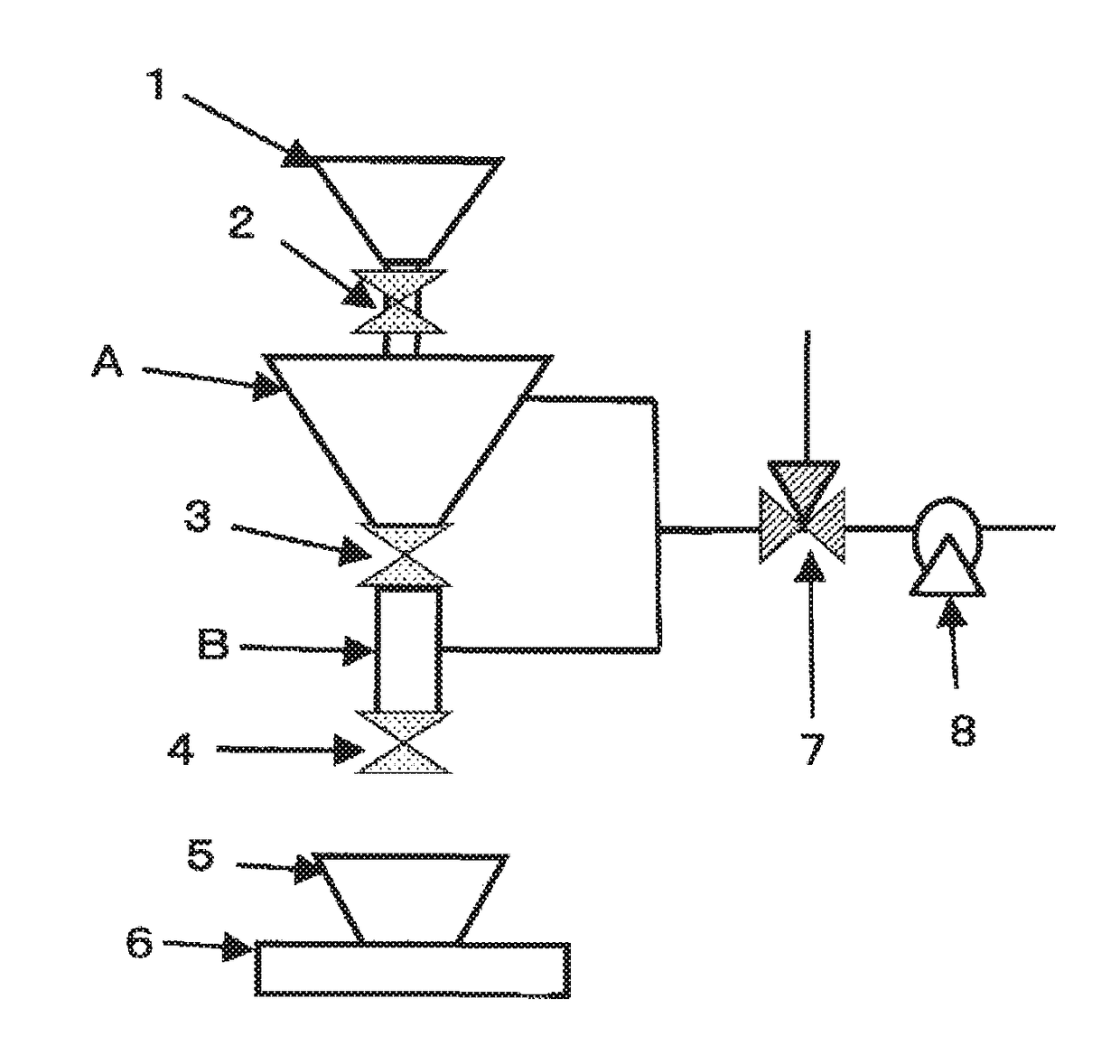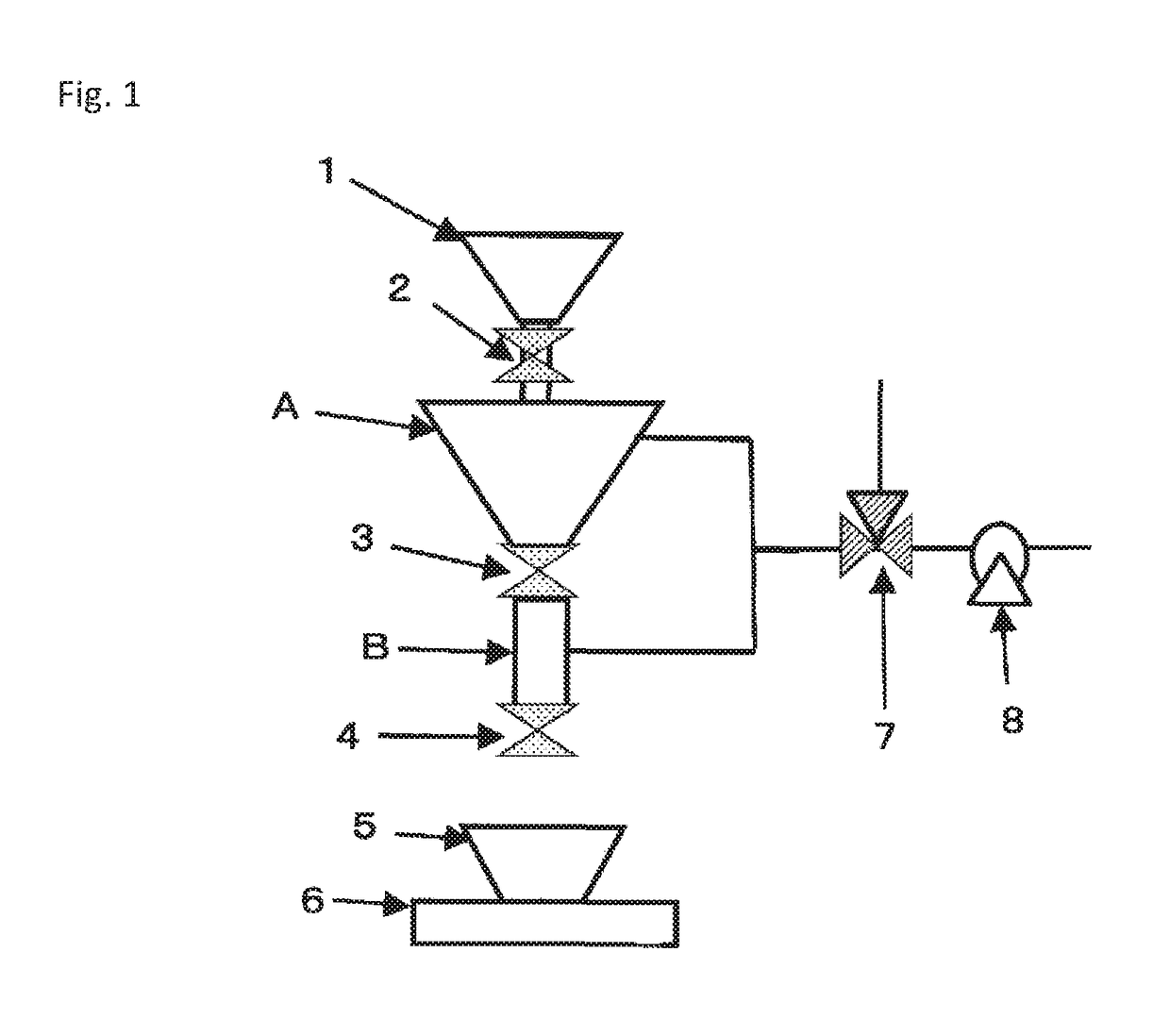Bulk-density measuring device for pre-expanded particles and method for manufacturing pre-expanded particles
a technology of bulk density and measuring device, which is applied in the direction of instruments, specific gravity measurement, material analysis, etc., to achieve the effect of stable measurement and easy manufacturing
- Summary
- Abstract
- Description
- Claims
- Application Information
AI Technical Summary
Benefits of technology
Problems solved by technology
Method used
Image
Examples
example 1
[0100]With 100 parts by weight of straight chain low-density polyethylene resin [MI=2.0 g / 10 min, melting point 122° C.], 0.2 parts by weight of glycerin [purified glycerin D manufactured by Lion Corporation] and 0.03 parts by weight of talc were dry-blended. The blend was supplied to a 50 φ single screw extruder at a discharge rate of 40 kg / hr, molten and kneaded at a resin temperature of 220° C., cooled with water, and then, cut with a pelletizer so as to obtain straight chain low-density polyethylene resin particles (4.5 mg / particle) having cylindrical shapes.
[0101]100 parts by weight of the obtained straight chain low-density polyethylene resin particles, 200 parts by weight of pure water, 0.5 parts by weight of tertiary calcium phosphate, and 0.05 parts by weight of sodium n-paraffin sulfonate were put in the pressure-resistant sealed vessel, and 7.5 parts by weight of carbon dioxide was introduced into the pressure-resistant sealed vessel while stirring the mixture. The obtain...
reference example 1
[0116]The second-stage expanded particles collected in Example 1 were left to stand for four hours in a dryer adjusted at 80° C. in order to recover them from contraction. After that, the bulk density of the second-stage expanded particles was measured using the well-known bulk-density measuring device as illustrated in FIG. 3.
[0117]The bulk density measurement results thereof are illustrated in Table 1.
[0118]The bulk densities of the second-stage expanded particles that were left to stand for four hours in the dryer adjusted at 80° C. and had been recovered from the contraction indicate similar values as the bulk densities (Example 1) measured by the bulk-density measuring device. In other words, the bulk densities within the target value were obtained. That is to say, it is found that the bulk density measured by the bulk-density measuring device could be measured as the bulk density of the original second-stage expanded particles.
reference example 2
[0119]The second-stage expanded particles collected in Comparative Example 1 were left to stand for four hours in a dryer adjusted at 80° C. in order to recover them from contraction. After that, the bulk density of the second-stage expanded particles was measured using the well-known bulk-density measuring device as illustrated in FIG. 3.
[0120]The bulk density measurement results thereof are illustrated in Table 1 and FIG. 4.
[0121]The bulk densities of the second-stage expanded particles that were left to stand for four hours in the dryer adjusted at 80° C. and had been recovered from the contraction were lower than the bulk densities (Comparative Example 1) of the second-stage expanded particles in the contracted state, which were measured by the conventional bulk-density measuring device. That is to say, it is found that the bulk densities (Comparative Example 1) of the second-stage expanded particles, which were measured by the conventional method, are different from the bulk de...
PUM
| Property | Measurement | Unit |
|---|---|---|
| angle | aaaaa | aaaaa |
| angle | aaaaa | aaaaa |
| internal pressures | aaaaa | aaaaa |
Abstract
Description
Claims
Application Information
 Login to View More
Login to View More - R&D
- Intellectual Property
- Life Sciences
- Materials
- Tech Scout
- Unparalleled Data Quality
- Higher Quality Content
- 60% Fewer Hallucinations
Browse by: Latest US Patents, China's latest patents, Technical Efficacy Thesaurus, Application Domain, Technology Topic, Popular Technical Reports.
© 2025 PatSnap. All rights reserved.Legal|Privacy policy|Modern Slavery Act Transparency Statement|Sitemap|About US| Contact US: help@patsnap.com



